Saint Therese of the Child Jesus
of the Holy Face
Entries in Lisieux Carmel (18)
St. Therese's Images of Mary - Chapel of Our Lady of Grace in Honfleur - May 14, 2017
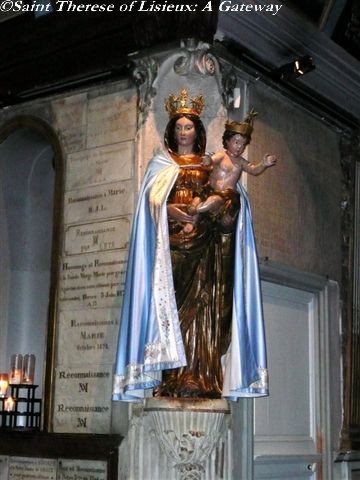 Statue of Our Lady of Grace in her chapel at Honfleur. Photo credit: Ann Hess
Statue of Our Lady of Grace in her chapel at Honfleur. Photo credit: Ann Hess
In June 1887, possibly on Saturday, June 18, Louis Martin took his three daughters, Leonie, Celine, and Therese, to visit an international maritime exhibit in Le Havre. They passed through the port of Honfleur and paused to pray at the Chapel of Our Lady of Grace, also called Our Lady of Consolation. At this mariners' chapel many missionaries and others who were leaving for the New World had come to pray to Our Lady for a safe crossing. The Martins are believed to have come here on other occasions.
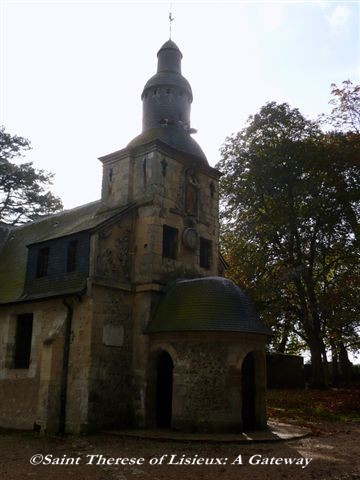 The chapel of Our Lady of Grace at Honfleur. Photo credit: Ann Hess
The chapel of Our Lady of Grace at Honfleur. Photo credit: Ann Hess
Therese, then 14, who on May 29 had received from her father permission to become a Carmelite, asked Our Lady to permit her to enter the Carmelite Monastery at Lisieux despite her youth.
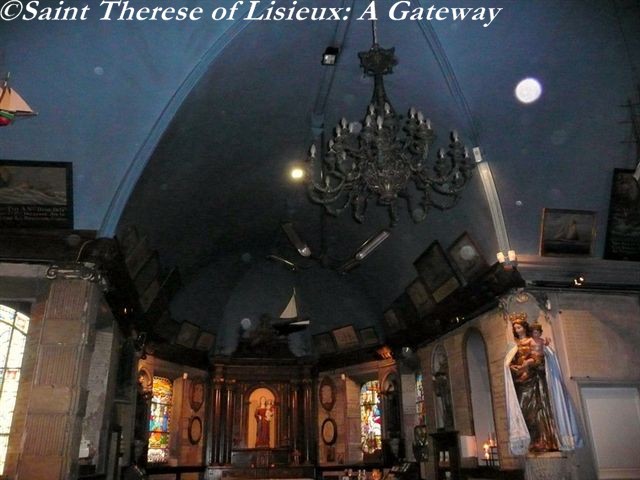 The main altar of the chapel of Our Lady of Grace at Honfleur. The statue before which Therese prayed is seen at right. Photo credit: Ann Hess
The main altar of the chapel of Our Lady of Grace at Honfleur. The statue before which Therese prayed is seen at right. Photo credit: Ann Hess
Leonie also prayed here for her vocation. She had made a six weeks' trial with the Poor Clares at Alencon the year before, and she would enter the Monastery of the Visitation at Caen in just a few weeks, on July 16, 1887. At this first trial with the Visitation, she remained for six months.
Fifty uears before Therese's visit, in 1837, two sisters, Athalie and Desiree Gosselin, had come with their priest-counselor, Fr. Nicolas Sauvage, to pray for the grace of being able to found the Carmelite monastery at Lisieux, the very monastery Therese later entered. A plaque in the chapel commemorates the visits of these three future Carmelites of Lisieux.
I had the privilege of visiting this chapel in 2008. It deeply moved my soul and my heart. I've never sensed in any other church or chapel the same atmosphere, and I recommend this little chapel to everyone who can make the pilgrimage. Whether or not we can go there physically, let's pray to Our Lady of Grace that, like Therese and Leonie, we may receive light to fulfill our own vocations. She will not refuse to hear us wherever we are.
St. Therese's Play "The Divine Little Beggar of Christmas," Carmel of Lisieux, December 25, 1895
Please see the beautiful photo of the wax doll of the newborn Jesus which was given to the Carmel of Lisieux in December 1895 by Therese's aunt and uncle, Isidore and Celine Guerin. The doll's hair is Therese's (cut when she was a child), and the Alencon lace on which the child is lying was made by Zelie Martin. The swansdown which lines the crib was part of the wedding dress Therese wore when she received the Habit on January 10, 1889; so was the child's tunic.
Thanks to the Web site of the Archives of the Carmel of Lisieux, we can recreate some scenes from Christmas 1895. This was the end of 1895, Therese's special year of grace, in which she wrote the first manuscript of Story of a Soul and offered herself to Mericful Love.
Writing to thank her parents, Therese's cousin, Sister Marie of the Eucharist, describes the scene when the gift arrived:
The reception of the case was an odd scene: all the little novices around the case, the dormitory was filled with our cries. Who would unpack the case: one was shouting: "I see a hand," another: "Oh! a pretty little head," and Sister Marie of the Sacred Heart was objecting and crying out in despair: "You will see, they will break it, they will not be satisfied until they do!"
It was a real comedy, or to express it better an impossible uproar. We could not be quiet until we each gave vent to our joy.
Letter from Sister Marie of the Eucharist to Isidore and Celine Guerin, December 20-25, 1895
On the night of December 25, 1895, the Carmelites gathered for a paraliturgical celebration designed by Therese; it appears in The Plays of St. Therese of Lisieux, titled "The Divine Little Beggar of Christmas: Asking Alms from the Carmelites." Each nun knelt in turn before this image of the Child Jesus, drew a folded note from a basket, and handed it to Sister Marie of the Eucharist, who sang a verse telling the nun what Jesus asked of her. Therese drew the verse saying that she would be the little cluster of grapes: "Jesus will press you very strongly in his beloved hand." In this little work of art Therese shows that she did not consider the image of the baby Jesus or the feast of Christmas sentimental; instead, the Incarnate God, entering into human history, empties himself so profoundly as to beg the love of his own creatures.
Note that this wax doll no doubt appeared again in Therese's play The Flight into Egypt, produced on January 21, 1896 for the feast-day of the prioress, Mother Agnes of Jesus (Therese's sister Pauline).
See Therese and Lisieux by Pierre Descouvement and Helmut-Nils Loose (Toronto: Novalis, 1996, p. 156 and pp. 162-163) and The Plays of Saint Therese of Lisieux, tr. Susan Conroy and David J. Dwyer (Washington, D.C.: Washington Province of Discalced Carmelites, 2008, pp. 221-246.
Letters from St. Therese's Sister Pauline, Mother Agnes of Jesus, to Sister Stanislaus of the Blessed Sacrament, 'Philadelphia's Little Flower' - Part 3, 1909-1911 - September 4, 2014
Read part one, "Sister Stanislaus of the Blessed Sacrament, 'Philadelpha's Little Flower'
Read part two, "Letters from St. Therese's Sister Pauline, Mother Agnes of Jesus, to Sister Stanislaus of the Blessed Sacrament, 'Philadelphia's Little Flower,' 1902-1909."
Read "St. Therese of Lisieux and Sister Mary of St. Joseph," which recounts the efforts of Sister Stanislaus’s childhood friend and fellow apostle, Sister Mary of St. Joseph, to make the spirituality of St. Therese known and loved.
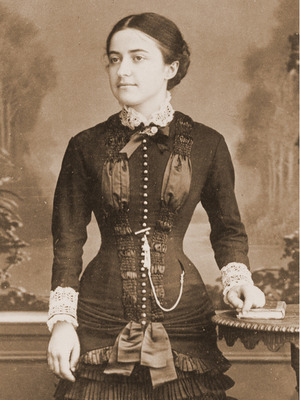 Mother Agnes of Jesus (Pauline Martin) as a laywoman. Photo credit: Web site of the Archives of the Carmel of Lisieux.
Mother Agnes of Jesus (Pauline Martin) as a laywoman. Photo credit: Web site of the Archives of the Carmel of Lisieux.
In the later years of the correspondence between Mother Agnes of Jesus, St. Therese's sister Pauline, in Lisieux and Sister Stanislaus of the Blessed Sacrament in Philadelphia, St. Therese's popularity was increasing dramatically. From July 1908 to July 1909, the Carmel of Lisieux had received more than 9,000 letters about Sister Therese from all five continents. Steps were being taken to introduce her cause. On May 8, 1908, Mother Marie-Ange of the Child Jesus, a saintly young nun who was wholeheartedly devoted to following St. Therese, was elected prioress of the Lisieux Carmel. That same day she wrote to the local bishop asking him to open an inquiry into the life and virtues of Sister Therese of the Child Jesus. On October 15, 1907, Bishop Lemonnier asked the Carmelites to write down their memories of Sister Therese of the Child Jesus. In Part 2 of this article, we had left Mother Agnes and Sister Stanislaus in January 1909. That very month Father Rodrigo of St Francis of Paola, a discalced Carmeite friar, was appointed postulator of the Cause, and Mgr Roger de Teil, canon of Notre-Dame Cathedral in Paris, was appointed vice-postulator.
About this time Sister Stanislaus sewed an outfit for the small statue of the Child Jesus that stood in the cloister of the Lisieux Carmel and which had been the special care of Sister Therese of the Child Jesus. On March 31, 1909, Mother Agnes wrote to Sister Stanislaus in Philadelphia to assure her that she had touched the robe to the statue of the Child Jesus and also to the statue of the Virgin that had smiled on Therese as a child: 'I have asked him to bless and kiss his little seamstress."
Again, as in her letter of July 17, 1903, Mother Agnes uses language suggesting that Sister Stanislaus has asked to see Therese's unpublished writings:
My dear child, regarding the pages of which you speak; you will read them only in heaven … but have patience, the exile is short. You will come up there into your little family. You are part of it, and there you will learn so many things! May it suffice you in this world to know that Thérèse has suffered much and has loved in proportion.
Mother Agnes acknowledges a gift from a friend of the Philadelphia Carmel and says that she can't fill an order for more rose petals or for certain books: "We do not have one single copy. All our books really have wings." Less than a dozen years after the death of Therese, the demand for souvenirs and writings was overwhelming.
Meanwhile Therese showed her affection for the Philadelphia Carmel. In this spring of 1909, Mother Gertrude had an attack of pneumonia complicated by heart disease. She received the Sacrament of the Sick. The community made a novena to Sister Therese for her cure. On the last day of the novena, Mother Gertrude recovered. On August 19, 1909, Mother Agnes wrote acknowledging that she had received the story of Mother Gertrude's cure. Sister Stanislaus had also experienced the mysterious perfumes with which Therese had also blessed the nuns at Lisieux after her death: sudden scents or flowers or of incense. When Sister Stanislaus opened a certain letter, she detected such a perfume. She must have doubted the phenomenon, for Mother Agnes writes "Oh, no, it was not of the imagination, but truly reality; be persuaded and rejoice fully in this gift." Nother Agnes asks Sister Stanislaus to copy out the text of this letter for her.
Mother Agnes speaks of the "perfume of suffering," for her young prioress, Mother Marie-Ange, is very ill (she would die in November) and has just received Extreme Unction, as the Sacrament of the Sick, then usually administered only to the dying, was called. She speaks of having received visitors who were friends of the Philadelphia Carmel.
It appears that certain books about Therese, translated into English, were then available in Great Britain but not in the U.S., and Mother Agnes refers Sister Stanislaus to Father Thomas Nimmo Taylor in Glasgow for information about these books. It appears that Sister Stanislaus and Mother Gertrude both corresponded with Father Thomas Taylor, who by this time was in touch with several English-speaking convents where Therese was loved. In 1910, when he testifies at the diocesan process for Therese, he will name the Philadelphia Carmel and quote from a letter he received from it:
In the United States, she has friends at the novitiate of the Sisters of Charity in Emmitsburg, and at the Philadelphia Carmel A letter from this Carmel speaks of “devotion to Sister Therese among rich and poor, priests and bishops.
As usual, Mother Agnes acknowledges having received payment and new orders from Philadelphia. She also speaks of an account of Therese's Cause, which she will later send to Philadelphia.
Mother Agnes closes tenderly:
For you, my little child, I kiss your forehead as I used to kiss the pure forehead of your sister in heaven.
On September 28, 1909, Isidore Guerin, the maternal uncle of the Martin sisters, died in Lisieux. On October 7, 1909, Mother Agnes writes to Sister Stanislaus: "We have just lost a benefactor in the person of my holy uncle, Monsieur Guerin. Pray for him; he was a Tertiary of Carmel." She mentions that Mother Marie-Ange is "near her last moments" and asks for prayers for her. She asks about the health of Mother Gertrude, saying "this news interests me very much." Again, she ends affectionately:
Goodbye now in Jesus, my little Stanislaus. May His love embrace you, may He find in you the same delights that He used to find before, in the heart of Thérèse!
In Lisieux, Mother Marie-Ange died on November 11, 1909. Mother Agnes replaced her as prioress; she would remain in this office for the rest of her life. On April 1, 1910, Mother Agnes writes again. Her tone suggests that she is late in answering a letter from Sister Stanislaus, for she calls herself a mother who "has more time for loving than for telling it and writing it." She says that she has sent the circular (death notice and life story) of Mother Marie-Ange, and has sent information about "the dear Cause which is as precious to you as it is to us; I truly feel it is so." This is a remarkable testimony of the depth of the fellow-feeling that existed between the Carmels of Lisieux and Philadelphia as early as 1909.
Mother Agnes laments knowing no English and says rather amusingly that she has no faith in the translations of Sister Therese of the Eucharist, a Carmelite of Lisieux who knew some English. Sister Therese of the Eucharist was the subject of a small biography, perhaps her "circular," published in French under the title “Mere Therese de L'Eucharistie Religieuse Carmelite de Lisieux 1885-1915. Carmel de Lisieux, 1916. Hardcover, 11x18cm. Il faut que les petites victimes d'amour soient immolees tout entieres.119pp.” According to Stephane-Joseph Piat's Celine: Sister and Witness of St. Therese of the Child Jesus, Therese of the Eucharist served as novice-mistress at Lisieux. With Marie-Ange of the Child Jesus and Isabel of the Sacred Heart, she completed a troika of saintly young Carmelites attracted to the Lisieux Carmel after Therese’s death. Like Therese, all three died young.
Three days after Mother Agnes mailed this letter, Bishop Lemonnier asked for all of Therese's writings to use them in the inquiry into her holiness, known as the "Process of the Writings," which began on May 23. On July 9, 1910, the Carmelite nuns in Philadelphia moved from their home at 44th and Spruce into "Hill Top," the farmhouse then standing on the land in the Oak Lane neighborhood of Philadelphia where their monastery stands today. By this time Sister Stanislaus of the Blessed Sacrament is very ill. In August she has a severe attack of gastritis.
On August 3, 1910, the diocesan tribunal to open the informative process (also called the "ordinary process" or the "bishop's process" is established at Caen. The diocesan process opens on August 12, 1910. Over the course of a year, the tribunal heard 48 witnesses, of whom the first was Mother Agnes, who testified from August 12 to 19, 1910 and again from August 27 through September 15, 1910. During her second session as a witness, on September 6, 1910, Therese's body is exhumed from the Carmelite plot in the town cemetery at Lisieux. (Exhumation of the body, though no longer mandatory, was at that time necessary for a candidate for sainthood).
Eleven days after she completes her testimony, on September 26, 1910, Mother Agnes writes to Sister Stanislaus again. Mother Agnes states that “the diocesan tribunal is sitting at this time to collect our depositions” and asks for prayers. On the day she wrote, she and Sister Marie of the Sacred Heart had already finished their depositions. Sister Genevieve, Celine, was testifying at this time (from September 14-28, 1910).
Mother Agnes says that the Carmel receives up to 92 letters a day and that this correspondence takes much time, so she writes only briefly to Sister Stanislaus. As if in answer to a request, she says “I can no longer send out anything of Mother Marie-Ange.” She writes that her two blood sisters “do not forget" Sister Stanislaus.
Meanwhile, in Philadelphia, Sister Stanislaus tries to resume her duties, but, by December, she has to stay in bed. On December 25, 1910, the Carmelites of Philadelphia had just finished a novena to the “Little Flower” for the cure of Sister Stanislaus. No longer able to walk, she is carried to Midnight Mass. On january 26, 1911, she receives the last sacraments. In February 1911 an epidemic of influenza ravaged the Lisieux Carmel. On February 5, 1911, Mother Agnes wrote her last surviving letter to Sister Stanislaus. Mother Agnes knows that Sister Stanislaus is ill, but the tone of her letter suggests that she is not aware that her young sister is dying. She urges Sister Stanislaus to take care of herself and to profit by the illness to advance on the path of Therese. She also marvels at the miracle Therese had worked at the Carmel of Gallipoli. Mother Agnes concludes:
Let us run together, my little child, in this child’s path, in confidence and abandonment. I know that you no longer have good legs but the wings of your soul must be substituted.
With these words Mother Agnes unknowingly closes her remarkable correspondence with the young Carmelite of Philadelphia who had done so much to make her little sister known and loved. Sister Stanislaus, now aged 31, will take flight "with the wings of her soul" to Heaven on March 10, 1911. One day I will write Part 4 of this article will tell the story of the death of Sister Stanislaus of the Blessed Sacrament and the letter about her which appeared in the appendix to the 1912 English edition of Story of a Soul.
"September 7, 2014: The Martin Family and the Carmel of Lisieux, and St. Therese and the Carmel of Philadelphia"
An Encounter with St. Thérèse of Lisieux
and her parents, Blessed Louis and Zélie Martin
Pray in the presence of their relics on Sunday, September 7, 2014
from 10:00 a.m. to 4:00 p.m.
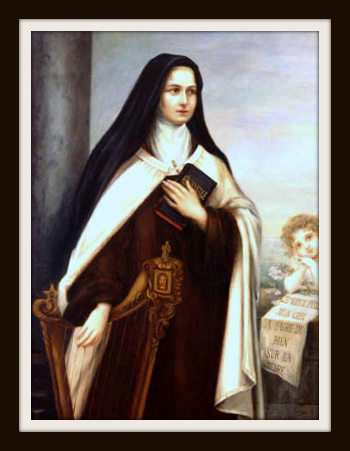 Portrait by St. Therese's sister Celine (Sister Genevieve),
Portrait by St. Therese's sister Celine (Sister Genevieve),
commissioned by Pauline Wilcox for the Philadelphia Carmel
“The Martin Family and the Carmel of Lisieux,
and St. Therese and the Carmel of Philadelphia"
- a conference by Maureen O’Riordan at 1:00 p.m.:
the Philadelphia Carmel, the birthplace of devotion to St. Therese in the U.S.
Benediction of the Most Blessed Sacrament at 3:30 p.m.
Carmelite Monastery Bookstore Open
1400 66th Avenue 10:00 a.m. to 3:30 p.m.
(66th Avenue and Broad Street) Spiritual books,
Philadelphia, Pa. children's books, DVDs,
Free parking in monastery lot and religious articles.
on 66th Avenue Cash and checks only
Chapel is handicapped-accessible.
Download the flyer
Learn more about the role of the Philadelphia Carmel in establishing devotion to St. Therese in the United States at their Web site, "Discalced Carmelites of Philadelphia."
"Residents of Lisieux View as 'Miracle' Sparing of Carmelite Convent and Basilica of 'The Little Flower' - September 30, 1944 - two Canadian war correspondents interviewed Carmelites at Lisieux

"Lisieux basilica". Licensed under CC BY-SA 2.0 via Wikimedia Commons
Immediately after the liberation of Lisieux on August 24, 1944, two Canadian newspapermen interviewed the Carmelites and other townspeople and cabled the story to Canada. Substantial excerpts from both stories about the "miracle of Lisieux" appeared in the Southern Cross, the newspaper of the diocese of Savannah, Georgia, on September 30, 1944. [Note: unfortunately, the archives of the Southern Cross have disappeared from the Web].
"[On the night of June 8, 1944] [f]lames roared and crackled over blocks of the town, creeping nearer and nearer to the convent. At the edge of the convent, perilously close to St. Therese's own chapel, the fire mysteriously slackened, then died out completely. The townsfolk observed this, and today they are convinced that St. Therese herself intervened . . . .
Devout brown-clad nuns of the Carmelite Order, to which Saint Therese belonged, today told me they believed the Saint had also intervened to spare the Basilica which bears her name. . . . I talked to Sister Anne of Jesus, aged 65 . . . to my surprise, I discovered the stooped, pale little nun was a Canadian, formerly Anne Goyer of Montreal . . . .
Tomorrow, a silent brown-garbed procession will walk quietly through the ruins of Lisieux, and the Carmelite nuns will once more step into silence and invisibility, which most will never leave again.
Richard Sanburn, writing from Lisieux for the Ottawa Citizen
I found the nuns eating a simple meal on benches in one of the little side chapels, the chapel of the Virgin of the Smile. In this and other side chapels of the crypt they have slept while men, women, and children have also been living and sleeping in close proximity, very different from the seclusion these women have known for years. There were mattresses even on the flagged floor on each side of the altar.
Frederick Griffin, writing from Lisieux for the Toronto Star